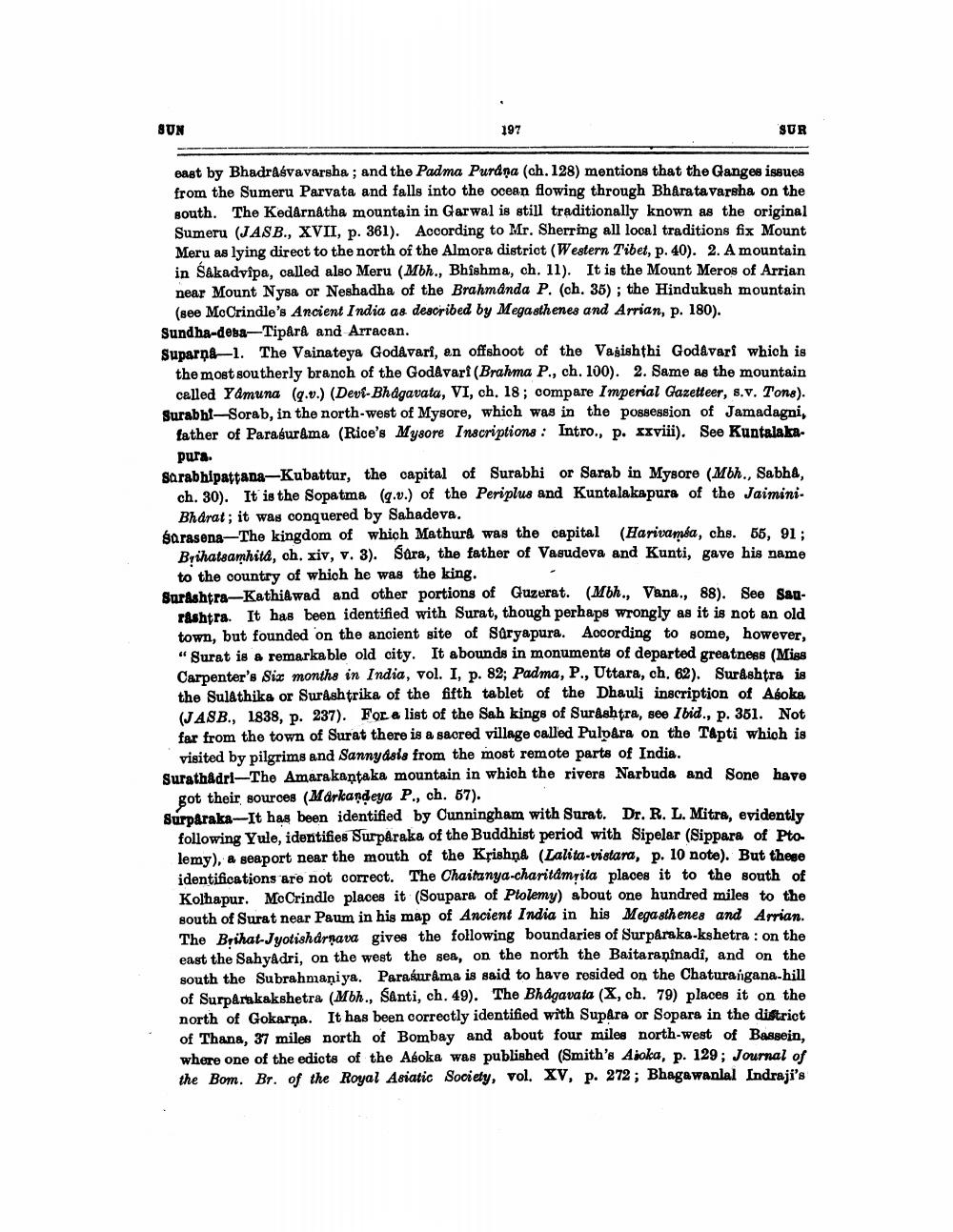________________
SUN
197
SUR
east by Bhadrasvavarsha; and the Padma Purana (ch. 128) mentions that the Ganges issues from the Sumeru Parvata and falls into the ocean flowing through Bharatavarsha on the south. The Kedarnatha mountain in Garwal is still traditionally known as the original Sumeru (JASB., XVII, p. 361). According to Mr. Sherring all local traditions fix Mount Meru as lying direct to the north of the Almora district (Western Tibet, p. 40). 2. A mountain in Śâkadvîpa, called also Meru (Mbh., Bhishma, ch. 11). It is the Mount Meros of Arrian near Mount Nysa or Neshadha of the Brahmânda P. (ch. 35); the Hindukush mountain (see McCrindle's Ancient India as described by Megasthenes and Arrian, p. 180). Sundha-desa-Tipârâ and Arracan.
Suparna-1. The Vainateya Godavari, an offshoot of the Vasishthi Godavari which is the most southerly branch of the Godavari (Brahma P., ch. 100). 2. Same as the mountain called Yamuna (q.v.) (Devi-Bhagavata, VI, ch. 18; compare Imperial Gazetteer, s.v. Tons). Surabhi-Sorab, in the north-west of Mysore, which was in the possession of Jamadagni, father of Parasurama (Rice's Mysore Inscriptions: Intro., p. xxviii). See Kuntalaka. pura.
Sarabhipattana-Kubattur, the capital of Surabhi or Sarab in Mysore (Mbh., Sabha, ch. 30). It is the Sopatma (q.v.) of the Periplus and Kuntalakapura of the JaiminiBharat; it was conquered by Sahadeva.
sarasena-The kingdom of which Mathura was the capital (Harivaméa, chs. 55, 91; Brihatsamhita, ch. xiv, v. 3). Sara, the father of Vasudeva and Kunti, gave his name to the country of which he was the king. Surashtra-Kathiawad and other portions of Guzerat. (Mbh., Vana., 88). See Saurashtra. It has been identified with Surat, though perhaps wrongly as it is not an old town, but founded on the ancient site of Suryapura. According to some, however, "Surat is a remarkable old city. It abounds in monuments of departed greatness (Miss Carpenter's Six months in India, vol. I, p. 82; Padma, P., Uttara, ch. 62). Surashtra is the Sulathika or Surashtrika of the fifth tablet of the Dhauli inscription of Asoka (JASB., 1838, p. 237). For a list of the Sah kings of Surashtra, see Ibid., p. 351. Not far from the town of Surat there is a sacred village called Pulpara on the Tapti which is visited by pilgrims and Sannyasis from the most remote parts of India.
Surathadri-The Amarakantaka mountain in which the rivers Narbuda and Sone have
got their sources (Märkandeya P., ch. 57).
Surparaka-It has been identified by Cunningham with Surat. Dr. R. L. Mitra, evidently following Yule, identifies Surparaka of the Buddhist period with Sipelar (Sippara of Ptolemy), a seaport near the mouth of the Krishna (Lalita-vistara, p. 10 note). But these identifications are not correct. The Chaitanya-charitâmṛita places it to the south of Kolhapur. McCrindle places it (Soupara of Ptolemy) about one hundred miles to the south of Surat near Paum in his map of Ancient India in his Megasthenes and Arrian. The Brihat-Jyotishârnava gives the following boundaries of Surpâraka-kshetra : on the east the Sahyadri, on the west the sea, on the north the Baitarapinadi, and on the south the Subrahmaniya. Parasurama is said to have resided on the Chaturangana-hill of Surpårakakshetra (Mbh., Santi, ch. 49). The Bhagavata (X, ch. 79) places it on the north of Gokarna. It has been correctly identified with Supara or Sopara in the district of Thana, 37 miles north of Bombay and about four miles north-west of Bassein, where one of the edicts of the Asoka was published (Smith's Aioka, p. 129; Journal of the Bom. Br. of the Royal Asiatic Society, vol. XV, p. 272; Bhagawanlal Indraji's




